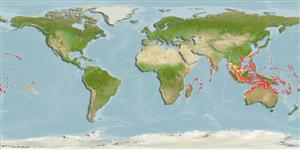Common names from other countries
>
Tetraodontiformes (Puffers and filefishes) >
Balistidae (Triggerfishes)
Etymology: Melichthys: Greek, melas, melaina, melan, black + icthys yos, fish. On the other hand, in Smith et al.,1986: 878), 'body dark brown to black' in https://www.biodiversitylibrary.org/item/266635#page/902/mode/1up.(P. Romero, pers.comm. 03/2022)..
More on author: Richardson.
Environment: milieu / climate zone / depth range / distribution range
Ecologia
marinhas associadas(os) a recifes; intervalo de profundidade 0 - 60 m (Ref. 1602). Tropical; 32°N - 31°S, 30°E - 132°W
Indo-Pacific: East Africa eastward through northern Australia to Hawaiian and Tuamotu islands, north to southern Japan.
Tamanho / Peso / Idade
Maturity: Lm ? range ? - ? cm
Max length : 40.0 cm TL macho/indeterminado; (Ref. 30573)
Espinhos dorsais (total) : 3; Raios dorsais moles (total) : 31 - 35; Espinhos anais: 0; Raios anais moles: 28 - 31. Juveniles with dark lines radiating from eye and dark lines on anal and soft dorsal fins (Ref. 4420).
Occur in seaward reefs to depths greater than 60 m (Ref. 9710, 48637), with rich invertebrate growth (Ref. 48637). Common in coral-rich areas exposed to currents (Ref. 1602). Usually at moderate depths in small loose groups (Ref. 48637). Benthopelagic (Ref. 58302). Diet consists mainly of algae and detritus but also takes in crustaceans, octopuses, sponges, and fishes (Ref. 1602). Oviparous (Ref. 205). Also taken with drive-in nets. Marketed fresh (Ref. 9770). Minimum depth reported taken from Ref. 128797.
Life cycle and mating behavior
Maturities | Reprodução | Spawnings | Egg(s) | Fecundities | Larvas
Oviparous, distinct pairing during breeding (Ref. 205).
Matsuura, K., 2001. Balistidae. Triggerfishes. p. 3911-3928. In K.E. Carpenter and V. Niem (eds.) FAO species identification guide for fishery purposes. The living marine resources of the Western Central Pacific. Vol. 6. Bony fishes part 4 (Labridae to Latimeriidae), estuarine crocodiles. FAO, Rome. (Ref. 9770)
Categoria na Lista Vermelha da IUCN (Ref. 130435)
CITES (Ref. 128078)
Not Evaluated
Ameaça para o homem
Harmless
Utilização humana
Warning: mysqli::__construct(): (HY000/1040): Too many connections in /var/www/html/includes/func_getlabel.php on line 46
Can't connect to MySQL database (fbapp). Errorcode: Too many connections
